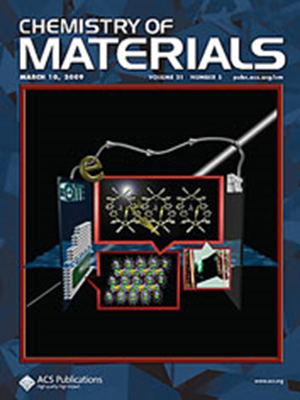Molecular Dynamics of Crystal-to-Glass Transition in Zero-Dimensional Organic–Inorganic Hybrid Halide (ITP)2SbBr5·CH2Cl2 for Multifunctional Application
IF 7.2
2区 材料科学
Q2 CHEMISTRY, PHYSICAL
引用次数: 0
Abstract
The molecular dynamics of organic–inorganic hybrid halide (OIHH) materials during phase transitions are of utmost importance for their practical applications. In this study, we obtained a novel zero-dimensional (0D) OIHH material (ITP)2SbBr5·CH2Cl2 with a unique matrix that allows for the control of the size and shape of its glass. The luminescent properties of both the (ITP)2SbBr5·CH2Cl2 crystal and glass exhibit photoluminescence quantum yields (PLQYs) of 82.13% and 36.23%, respectively. DFT calculation shows that the indirect band gap of the sample is 2.44 eV. AIMD simulations confirm the structural retention of [ITP]+ and [SbBr5]2– units during melting, explaining the high thermal stability of the glass. The structure and optical properties of (ITP)2SbBr5·CH2Cl2 are thoroughly investigated, revealing its potential as a high-performance scintillator with superior light output and spatial resolution in X-ray imaging, as well as its effectiveness in agricultural lighting technology.

零维有机-无机杂化卤化物(ITP)2SbBr5·CH2Cl2晶体到玻璃转变的分子动力学及其多功能应用
有机-无机杂化卤化物(OIHH)材料相变过程中的分子动力学研究对其实际应用具有重要意义。在这项研究中,我们获得了一种新的零维(0D) OIHH材料(ITP)2SbBr5·CH2Cl2,具有独特的基质,可以控制其玻璃的大小和形状。(ITP)2SbBr5·CH2Cl2晶体的发光性能和玻璃的光致发光量子产率分别为82.13%和36.23%。DFT计算表明,样品的间接带隙为2.44 eV。AIMD模拟证实了[ITP]+和[SbBr5]2 -单元在熔融过程中的结构保留,解释了玻璃的高热稳定性。对(ITP)2SbBr5·CH2Cl2的结构和光学性质进行了深入研究,揭示了其作为高性能闪烁体的潜力,在x射线成像中具有优越的光输出和空间分辨率,以及在农业照明技术中的有效性。
本文章由计算机程序翻译,如有差异,请以英文原文为准。
求助全文
约1分钟内获得全文
求助全文
来源期刊

Chemistry of Materials
工程技术-材料科学:综合
CiteScore
14.10
自引率
5.80%
发文量
929
审稿时长
1.5 months
期刊介绍:
The journal Chemistry of Materials focuses on publishing original research at the intersection of materials science and chemistry. The studies published in the journal involve chemistry as a prominent component and explore topics such as the design, synthesis, characterization, processing, understanding, and application of functional or potentially functional materials. The journal covers various areas of interest, including inorganic and organic solid-state chemistry, nanomaterials, biomaterials, thin films and polymers, and composite/hybrid materials. The journal particularly seeks papers that highlight the creation or development of innovative materials with novel optical, electrical, magnetic, catalytic, or mechanical properties. It is essential that manuscripts on these topics have a primary focus on the chemistry of materials and represent a significant advancement compared to prior research. Before external reviews are sought, submitted manuscripts undergo a review process by a minimum of two editors to ensure their appropriateness for the journal and the presence of sufficient evidence of a significant advance that will be of broad interest to the materials chemistry community.
 求助内容:
求助内容: 应助结果提醒方式:
应助结果提醒方式:


